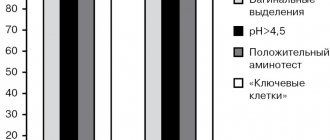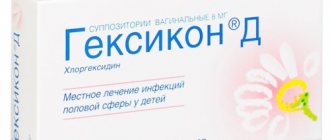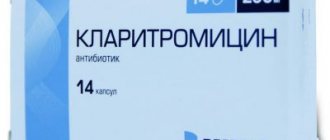Candidiasis - what is it
Candidiasis is a disease caused by a fungus of the genus Candida. This fungus is present in the vagina of the vast majority of women. In developed countries, Candida spores are recognized as a conditionally pathogenic flora. That is, the presence of traces of this fungus in tests is not an indication for treatment if there are no accompanying symptoms. The female vagina contains countless microorganisms. In each specific case, this is the individual composition of the flora.
When a person’s immunity is not weakened, pathogenic bacteria and fungi only provide balance to the constant environment. But as soon as the immunity weakens or an infectious infection occurs, allowing opportunistic microorganisms to gain numerical superiority over other representatives of the microflora, signs of the disease appear.
Candidiasis occurs in the following cases:
- weakened immunity, for example, as a result of pregnancy;
- the balance of the intestinal and vaginal microflora is disturbed, for example, as a result of poisoning or abuse of sweets, as well as after long-term use of large doses of antibiotics;
- infection occurs after unprotected sexual intercourse with a partner who is a carrier of candidiasis;
Regardless of what caused the thrush, drugs from the group of fungicides are prescribed.
Symptoms of thrush
One of the most striking and recognizable symptoms is copious curdled vaginal discharge. They do not always have a characteristic smell. However, thrush may initially present itself differently, before heavy discharge becomes noticeable:
- redness of the mucous membrane of the labia minora, a feeling of sticking together;
- burning sensation spreading to the inner surface of the labia minora during contact with water or during urination;
- itching at the entrance to the vagina;
- peeling, spreading not only to the genital area, but also to the anus.
In men, thrush appears as a white coating and rash that covers the head of the penis. If candidiasis in a man was caused by a malnutrition (poisoning or excessive consumption of sweets), then the disease will manifest itself as itching around the anal ring.
Candidiasis can affect not only the mucous membranes of the genital organs. In infants, thrush often occurs in the mouth when the body experiences a lack of fluid. In adults, oral thrush may appear after taking large doses of antibiotics. It manifests itself as redness of the inner surface of the cheeks, tongue and gums. An astringent sensation is created in the mouth, accompanied by a white coating.
Drugs for candidiasis
For women, the most effective medications are those available in the form of vaginal suppositories. They act locally and, as a rule, allow you to get rid of unpleasant symptoms after a couple of uses. Modern pharmacology offers drugs, including for pregnant women.
Men are prescribed antifungal medications in the form of creams that work when applied to the infected area of the genitals or anus. In special cases, including relapses, tablets are prescribed for the systemic treatment of thrush.
Each product contains an active substance that does not allow Candida fungi to multiply.
Suppositories Livarol
Suppositories for the treatment of fungal vulvovaginitis have ketoconazole as the active substance. This substance stops the vital activity of not only fungi, but also some bacteria, including staphylococcus and streptococcus. The substance helps well with primary infections. In the case of a chronic form of thrush, Livarol will not have the expected effect, because ketoconazole is a substance to which Candida fungi become resistant over time.
Livarol will cope with a mild form of thrush in 5 days. In special cases, the doctor may prescribe a 10-day course. The drug is sold in appropriate dosages: 5 and 10 suppositories per package.
The suppositories, once in the vagina, quickly take on a liquid form and envelop the mucous membranes of the organ. To achieve the maximum duration of contact of the substance with the contaminated surface, it is better to place suppositories at night. So that when the medicine becomes liquid, it does not leak out of the vagina.
CANDIDE (tablets)
the drug, on the other - the company.
It was sealed in a plastic bag, like baby juice straws. The tablet itself is 2 cm by 1 cm, 0.5 cm thick.
The shape of a truncated oval with embossing: the letter “G” on one side and “V6” on the other. The tablet is smooth, but without a sliding coating, matte - uncomfortable to administer...
Pregnant women are afraid to prescribe systemic drugs (such as Flucostat, Diflucan), which is probably why they treated me so hard in 3 rounds. First visit - 5 days of Livarol suppositories: tests are not very good; second call - 3 days of Pimafucin suppositories: better tests, but need to finish off; and the third visit - 6 days of Candid-B6 vaginal tablets.
After the first cycle of treatment (with Livarol), thrush did not give me any problems; the tests said that I needed treatment. After the second course (with Pimafucin), the analysis was controversial - my very experienced midwife immediately said that with such numbers, treatment was no longer prescribed, but, of course, I should listen to the gynecologist. But the manager (it was just 30 weeks, so the appointment was conducted by the manager) made an appointment, explaining that the birth was close and everything needed to be removed as much as possible, even though the figure was “on the verge of carrier status.” Here…
Pros: small. Sorry for the details, it comes out well, that is, at one time and not as much and liquid as candles (the same Livarol). Again, the base is non-greasy and washes off the skin easily.
The blister is very dense; the first tablet was squeezed out, like all tablets of this kind - just by pressing, so it broke in the middle. The foil is very thick. To avoid breaking the rest, she removed them by breaking through the foil with her fingernail and taking out a tablet.
I didn't really like the appearance of the applicator. Hard plastic, not too streamlined, flimsy. The piston inside is “walking” like the tongue of a bell.” I did not have a chance to use it, because it is not recommended for pregnant women. Maybe he is quite good)))
In terms of speed of impact - after the first use, the discharge became less. There was a slight discomfort in the abdomen, I can’t even say that in the female organs - specifically in the abdominal cavity, for some reason... So in terms of action it is good, although it did not treat the very peak of thrush, but only “finished off”, being already the third drug...
Almost 6 months have passed since the treatment, of which 4.5 months have passed since birth, and there is no thrush. Although in the maternity hospital I was injected with an antibiotic for 5 days. Candide has its advantages, so I will recommend it, but I hope that you will not need it.
The drug Clotrimazole
Clotrimazole is available in both ointment and tablet form. But the tablets are not intended for oral administration. They are used as suppositories, placed in the vagina. The active substance is clotrimazole. It disrupts the production of their main component by fungal cells. As a result, the fungus first cannot reproduce and then dies. The main advantage of vaginal tablets is their low cost.
The main contraindication to the use of Clotrimazole is pregnancy. In other cases, in the absence of allergic reactions to the drug, the drug can be used both at the first manifestations of thrush and in case of relapse.
Candide-b6 100 mg 6 pcs. vaginal tablets with applicator
pharmachologic effect
Antifungal agent.
Composition and release form Candide-b6 100 mg 6 pcs. vaginal tablets with applicator
Tablets - 1 tablet:
- Active substance: Clotrimazole - 100.0 mg;
- Excipients: adipic acid 70.0 mg, corn starch 260.0 mg, colloidal silicon dioxide 2.67 mg, lactose monohydrate 483.33 mg, magnesium stearate 4.0 mg, methyl parahydroxybenzoate 0.8 mg, sodium bicarbonate 54.67 mg, sodium carboxymethyl starch 42.0 mg, povidone K-30 12.67 mg, propyl parahydroxybenzoate 0.2 mg, talc 10.0 mg.
6 tablets per aluminum foil strip. 1 strip along with an applicator and instructions for use in a cardboard box.
Description of the dosage form
White, biconvex, uncoated tablets, oval in shape, truncated on one side, with the monogram "G" on one side and the sign "V6" on the other side.
Characteristic
Clotrimazole is an imidazole derivative. Broad-spectrum antifungal agent.
Directions for use and doses
Locally. For intravaginal use only. Vaginal tablets are administered in the evening into the vagina, lying as deeply as possible on your back with slightly bent legs, 1 vaginal tablet 100 mg daily for 6 days. A repeated course of treatment is possible after consulting a doctor.
To sanitize the birth canal before childbirth, a single administration of one tablet is recommended.
Instructions for using the applicator:
- Pull out the applicator plunger as far as it will go. Place one vaginal tablet into the applicator;
- Carefully insert the applicator with the tablet as deep as possible into the vagina (it is best to lie on your back with your legs slightly bent);
- Insert the tablet into the vagina, slowly pressing the piston of the applicator until it stops;
- Remove the applicator;
- After use and before reuse, remove the plunger completely from the applicator, wash the plunger and applicator with warm (not hot) soapy water and wipe dry.
Pharmacodynamics
Pharmacological action - broad-spectrum antifungal agent for topical use, antibacterial, antiprotozoal, trichomonacid. The antimycotic effect of the active ingredient clotrimazole (imidazole derivative) is associated with a disruption in the synthesis of ergosterol, which is part of the cell membrane of fungi, which changes the permeability of the membrane and causes subsequent cell lysis. At fungicidal concentrations, it interacts with mitochondrial and peroxidase enzymes, resulting in an increase in the concentration of hydrogen peroxide to a toxic level, which also contributes to the destruction of fungal cells.
Clotrimazole is active against the following pathogens:
- Blastomyces dermatitidis;
- Candida spp (has the same activity as nystatin);
- Coccidioides immitisl;
- Cryptococcus neoformans (Torula histolytica);
- Dermatophytes (Trichophyton, Microsporum, Epidermophyton);
- Histoplasma capsulatum;
- Malassezia furfur;
- Naegleria fowleri;
- Nocardia spp;
- Paracoccidioides brasiliensis;
- Sporotrichum schenckii
Effective against gram-positive bacteria - the causative agent of erythrasma Corynebacterium minutissimum, as well as Staphylococcus spp., Streptococcus spp., gram-negative bacteria - Bacteroides, Gardnerella vaginalis. In high concentrations it is active against Trichomonas vaginalis.
Pharmacokinetics
When using clotrimazole intravaginally, absorption is 3-10% of the administered dose. High concentrations in vaginal secretions and low concentrations in blood persist for 48-72 hours. Rapidly metabolized in the liver to inactive metabolites.
Indications for use Candide-b6 100 mg 6 pcs. vaginal tablets with applicator
- Genital infections caused by yeast-like fungi of the genus Candida and/or Ttrichomonas vaginalis (vulvovaginal candidiasis, trichomoniasis);
- genital superinfections caused by microorganisms sensitive to cpotrimazole;
- sanitation of the birth canal before childbirth.
Contraindications
- Hypersensitivity to clotrimazole and other components of the drug;
- I trimester of pregnancy.
With caution: lactation period.
Application of Candide-b6 100 mg 6 pcs. vaginal tablets with applicator during pregnancy and breastfeeding
Contraindicated for use in the first trimester of pregnancy. The question of the advisability of prescribing the drug in the second or third trimesters should be decided individually after consultation with a doctor. When prescribing the drug during the second or third trimesters of pregnancy, the ratio of the expected benefit of prescribing the drug for the mother and the possible risk to the fetus should be taken into account. It is not advisable to use a vaginal applicator. Use caution during breastfeeding (it is unknown whether clotrimazole passes into breast milk).
special instructions
To prevent urogenital infection, simultaneous treatment of sexual partners is necessary.
For trichomoniasis, for more successful treatment, other drugs that have a systemic effect (for example, metronidazole orally) should be used together with Candida-Vb.
In case of simultaneous infection of the labia and adjacent areas (candidal vulvitis), additional local treatment with Candida cream should be carried out.
During pregnancy, treatment with vaginal tablets should be carried out without an applicator.
In patients with liver failure, the functional state of the liver should be periodically monitored.
If signs of hypersensitivity or irritation appear, treatment is discontinued.
If there is no effect within 6 days, the diagnosis should be confirmed.
Be careful during lactation.
The use of tablets should be avoided during menstruation.
Should not be used in children under 12 years of age.
Overdose
The use of the drug in high doses does not cause any reactions or life-threatening conditions. In case of unintended use of the drug (orally), the following symptoms are possible: anorexia, nausea, vomiting, gastralgia, liver dysfunction; rarely - drowsiness, hallucinations, lollakiuria, allergic skin reactions.
There is no specific antidote. It is necessary to take activated carbon internally. If necessary, treatment is symptomatic.
Side effects of Candide-b6 100 mg 6 pcs. vaginal tablets with applicator
Itching, burning and swelling of the vaginal mucosa, vaginal discharge, headache, gastralgia, frequent urination, intercurrent cystitis, burning sensation in the penis of the sexual partner, pain during sexual intercourse.
Drug interactions
When administered vaginally, Clotrimazole reduces the effectiveness of amphotericin B and other polyene antibiotics. When used simultaneously with nystatin, the activity of clotrimazole may be reduced.
Pimafucin for thrush
The main advantage of Pimafucin is the safety of use in pregnant and lactating women. The initial stages of the disease are easily eliminated with three suppositories. The active ingredient in Pimafucin is natamycin. It is a strong antifungal agent that can relieve a woman of candidiasis in three days. As a rule, the drug does not cause addiction, so it can successfully treat relapses of fungal infections.
I often use Pimafucin to treat both partners. This drug is available in the form of suppositories, creams and tablets for oral administration. The only downside of this drug is the price, which is slightly higher in comparison with other drugs.
Vaginal and thrush medications
Vaginal medications for thrush
Local antifungal agents are used to treat acute or recurrent uncomplicated candidiasis. They act directly on the infection locally in the affected area, i.e. on the skin and vaginal mucosa. The drugs are presented in several dosage forms:
- Vaginal tablets are convenient and their use is not associated with systemic side effects. Intravaginal tablets act locally, preventing the growth of the fungus on the skin and vaginal mucosa.
- Vaginal suppositories are suitable for the treatment of almost all types of VVC, except for severe ones, when a systemic effect is required. It should be noted that suppositories created on the basis of oil components can violate the integrity of latex contraceptives (condoms and diaphragms).
- Creams and ointments are no less common forms of thrush remedies.
Among local antimycotics in Russia, the following active ingredients are most often used:
- ketoconazole;
- natamycin;
- clotrimazole;
- miconazole;
- sertaconazole;
- nystatin;
- fenticonazole;
- econazole
Vaginal antifungal agents for thrush successfully fight the pathogen, however, in order to alleviate the patient’s condition as quickly as possible in the acute phase of the disease, additional anti-inflammatory and healing therapy is necessary. At the same time, to prevent relapses, especially those caused by viral-bacterial associations, drug support of local immunity and antiviral treatment are recommended. Epigen Intim spray has a complex effect in the listed areas thanks to the active component of the drug - glycyrrhizic acid. The unique method of its activation, created by the developers of the drug, significantly enhances the therapeutic effects of the active substance:
- acceleration of regeneration of damaged tissues;
- reduction of inflammation;
- increasing local immunity;
- antiviral effect - fight against viral-fungal associations;
- elimination of itching, burning, dryness.
The drug accumulates in the lesions, while it penetrates into the systemic bloodstream slowly - the drug is found in the blood only in trace amounts. Can be used by pregnant women and during breastfeeding. The spray is equipped with nozzles for intravaginal and external use, which makes its use as convenient as possible.
When the body is weakened or exposed to factors that disrupt the normal microflora of the vagina, local antifungal drugs are prescribed as part of preventive measures. The preventive use of Epigen Intim spray will help strengthen protection against relapses of thrush. Its use is indicated when taking antibiotics, weakening the body after hypothermia, respiratory viral infections, stress, and during travel.


